ARTICLES
Excerpt from “Spatial behaviour of translocated African elephants (Loxodonta africana) in a novel environment: using behaviour to inform conservation actions”
 “During September 2005, 150 African elephants were translocated from Shimba Hills National Reserve and Mwaluganje Elephant Sanctuary on the coast of Kenya (4–4.3.S and 39.5–39.3.E) to Tsavo East National Park (2.00–3.70.S and 38.13–39.30.E), a distance of 160 km (Figure 1) as part of Kenya’s Wildlife Service (KENYA WILDLIFE SERVICE) effort to decrease human-elephant conflict around Shimba Hills. The translocation was conducted by the KENYA WILDLIFE SERVICE according to the IUCN elephant translocation guidelines (Dublin & Niskanen, 2003) and funded by the Kenya Government. Elephant groups of fewer than 12 individuals were targeted and transported as intact units. Adult males were targeted based on their location and accessibility by road during the translocation and were moved in pairs.
“During September 2005, 150 African elephants were translocated from Shimba Hills National Reserve and Mwaluganje Elephant Sanctuary on the coast of Kenya (4–4.3.S and 39.5–39.3.E) to Tsavo East National Park (2.00–3.70.S and 38.13–39.30.E), a distance of 160 km (Figure 1) as part of Kenya’s Wildlife Service (KENYA WILDLIFE SERVICE) effort to decrease human-elephant conflict around Shimba Hills. The translocation was conducted by the KENYA WILDLIFE SERVICE according to the IUCN elephant translocation guidelines (Dublin & Niskanen, 2003) and funded by the Kenya Government. Elephant groups of fewer than 12 individuals were targeted and transported as intact units. Adult males were targeted based on their location and accessibility by road during the translocation and were moved in pairs.
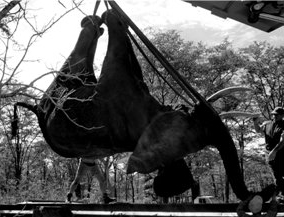 The elephants were released in a ‘hard release’ method i.e., were allowed to walk directly into the park from the transportation trucks and not kept in an enclosure. The translocation of the 150 elephants took 32 days during which 20 groups (average ± SD group size 6.8 ± 2.5) and 20 adult males were moved. The release site, Tsavo East, differs greatly from the source site, Shimba Hills, in its climate, vegetation, size, and elephant density. Tsavo East is semi arid with an average annual rainfall ranging from 300 to 700 mm, while Shimba Hills is part of the coastal plateau with an average annual rainfall of 1500 mm and a humid equatorial climate. During the rains, vegetation growth in Tsavo East is spatially heterogeneous and unpredictable, in contrast to the spatially homogeneous and reliable vegetation growth in Shimba Hills (van Wijngaarden, 1985). Tsavo East is the largest national park in Kenya (13 950 km2) and along with the adjacent Tsavo West National Park forms the largest protected area in the country (20 812 km2), which is home to approx. 11000 elephants ; density = 0.43 elephants/km2. The source site, Shimba Hills is a small (250 km2) reserve surrounded by human settlements containing approx. 600 elephants (Blanc et al., 2007); density = 2.4 elephants/km2.
The elephants were released in a ‘hard release’ method i.e., were allowed to walk directly into the park from the transportation trucks and not kept in an enclosure. The translocation of the 150 elephants took 32 days during which 20 groups (average ± SD group size 6.8 ± 2.5) and 20 adult males were moved. The release site, Tsavo East, differs greatly from the source site, Shimba Hills, in its climate, vegetation, size, and elephant density. Tsavo East is semi arid with an average annual rainfall ranging from 300 to 700 mm, while Shimba Hills is part of the coastal plateau with an average annual rainfall of 1500 mm and a humid equatorial climate. During the rains, vegetation growth in Tsavo East is spatially heterogeneous and unpredictable, in contrast to the spatially homogeneous and reliable vegetation growth in Shimba Hills (van Wijngaarden, 1985). Tsavo East is the largest national park in Kenya (13 950 km2) and along with the adjacent Tsavo West National Park forms the largest protected area in the country (20 812 km2), which is home to approx. 11000 elephants ; density = 0.43 elephants/km2. The source site, Shimba Hills is a small (250 km2) reserve surrounded by human settlements containing approx. 600 elephants (Blanc et al., 2007); density = 2.4 elephants/km2.
REFERENCES
Dublin, H.T. & Niskanen, L.S. (2003). IUCN/SSC AfESG Guidelines for the in situ translocation of the African elephant for conservation purposes. — IUCN, Gland and Cambridge.
van Wijngaarden, W. (1985). Elephants-trees-grass-grazers: relationships between climate, soils, vegetation and large herbivores in a semi-arid savanna ecosystem (Tsavo, Kenya). —ITC, Enschede.
Blanc, J.J., Barnes, R.F.W., Craig, G.C., Dublin, H.T., Thouless, C.R., Douglas-Hamilton, I. & Hart, J.A. (2007). African elephant status report 2007: an update from the African elephant database. — IUCN/SSC/AfESG occasional paper of the IUCN Species Survival Commission, Gland.
SOURCE:
Kwale Schoolgirl Killed by Elephant
KWALE, Kenya, (Rose Kamau) Jul 2 - A school girl was reportedly killed and a man seriously injured when an elephant attacked them in Kwale district.The girl is said to have been returning home from school at Mtaa area with her fellow students and had just taken a different path when the jumbo struck.The girl's friends tried to raise an alarm warning the girl that the elephants were ahead of her but she seems to have misheard them as she ran full tilt towards the herd.One of the elephants incensed by the girl's screams seized her and trampled on her to death. The second victim was in a nearby forest when he heard the girls' screams. His attempts to run away from the jumbos were futile as one of them seized him and threw him up in the air. The man escaped when his shirt came off and he ran, leaving the elephant trampling on the shirt.
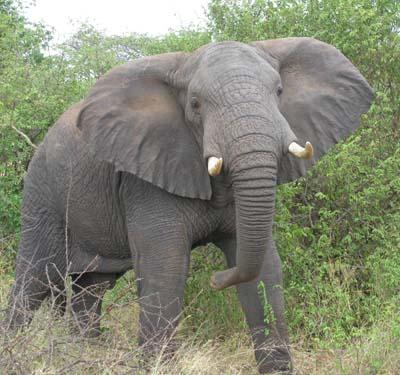 Local Kenya Wildlife Service Warden Peter Nderitu confirmed the attack saying instances of increased human-wildlife conflict in the area have been on the increase since this is the elephants' migration season. He further attributed the conflicts to human settlements which have encroached on the elephants' migratory corridors. The area has been experiencing a drought which has reduced grass and foliage causing the elephants to venture further out of the forests. The situation has been exacerbated by the degradation of the environment through charcoal burning and deforestation which have destroyed the animals' natural habitat. Nderitu said a patrol unit had been sent over from Nanyuki to boost patrols in the area while an outpost has been opened at Kinango and the officers equipped with motorbikes for fast response in case of attacks by animals. "KWS will set up a hot line through which community members can call in case of an attack by elephants or buffaloes that are resident in the area," he said. "A one km stretch of electric fencing at the Shimba Hills Reserve is also under repair at the cost of Ksh1 million which should keep the animals confined in the reserve," he added.
Local Kenya Wildlife Service Warden Peter Nderitu confirmed the attack saying instances of increased human-wildlife conflict in the area have been on the increase since this is the elephants' migration season. He further attributed the conflicts to human settlements which have encroached on the elephants' migratory corridors. The area has been experiencing a drought which has reduced grass and foliage causing the elephants to venture further out of the forests. The situation has been exacerbated by the degradation of the environment through charcoal burning and deforestation which have destroyed the animals' natural habitat. Nderitu said a patrol unit had been sent over from Nanyuki to boost patrols in the area while an outpost has been opened at Kinango and the officers equipped with motorbikes for fast response in case of attacks by animals. "KWS will set up a hot line through which community members can call in case of an attack by elephants or buffaloes that are resident in the area," he said. "A one km stretch of electric fencing at the Shimba Hills Reserve is also under repair at the cost of Ksh1 million which should keep the animals confined in the reserve," he added.
SOURCE:
Acute Water Shortage in Kwale Town
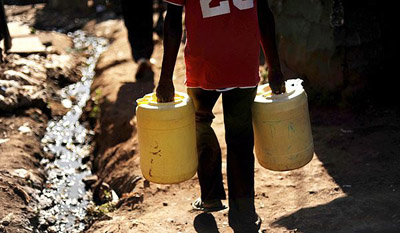 “An acute water shortage has hit Kwale town and its environs as taps remained dry for the second week. Residents have been forced to draw water from nearby rivers exposing themselves to the risk of being attacked by rogue elephants from national parks and game reserves within the area.
Residents now travel long distances to get the essential commodity despite a water station at the nearby Marere River. A civic leader at Kwale County Council Ali Hamisi Boga blamed the shortage on Kwale Water and Sewerage Company personnel saying their laxity had brought suffering to the residents. “It is ironical for the residents of this town, which is only three kilometres away, to continue suffering yet hoteliers along the beaches and Mombasa residents bask in glory of the water from this source,” said Boga.
“An acute water shortage has hit Kwale town and its environs as taps remained dry for the second week. Residents have been forced to draw water from nearby rivers exposing themselves to the risk of being attacked by rogue elephants from national parks and game reserves within the area.
Residents now travel long distances to get the essential commodity despite a water station at the nearby Marere River. A civic leader at Kwale County Council Ali Hamisi Boga blamed the shortage on Kwale Water and Sewerage Company personnel saying their laxity had brought suffering to the residents. “It is ironical for the residents of this town, which is only three kilometres away, to continue suffering yet hoteliers along the beaches and Mombasa residents bask in glory of the water from this source,” said Boga.
 Residents have to pass through the Mwalughanje Elephant Sanctuary before drawing water at the Marere river. The area has been infested by marauding jumbos straying from Mwaluganje and Shimba Hills National Game reserves. A resident, Biasha Juma, said they have now been forced to suspend other activities to get water before it is late as away of avoid attacks from the jumbos. “For the last two weeks getting water has been the only activity we do over the day as it has replaced whatever we ought to do because we cannot dare going to the river when it’s late. Elephants roam,” she said.
But a top Kwale Water Company official Ali Chalala said the situation is being addressed and promised the residents that water would be flowing soon. “What has been going on is a low supply of water and we are doing everything possible to ensure that this problem is solved once and for all within the shortest time possible,” he said.”
Residents have to pass through the Mwalughanje Elephant Sanctuary before drawing water at the Marere river. The area has been infested by marauding jumbos straying from Mwaluganje and Shimba Hills National Game reserves. A resident, Biasha Juma, said they have now been forced to suspend other activities to get water before it is late as away of avoid attacks from the jumbos. “For the last two weeks getting water has been the only activity we do over the day as it has replaced whatever we ought to do because we cannot dare going to the river when it’s late. Elephants roam,” she said.
But a top Kwale Water Company official Ali Chalala said the situation is being addressed and promised the residents that water would be flowing soon. “What has been going on is a low supply of water and we are doing everything possible to ensure that this problem is solved once and for all within the shortest time possible,” he said.”
SOURCE:
Colonization of Forest Elephant Dung by Invertebrates in the Bossematié Forest Reserve, Ivory Coast
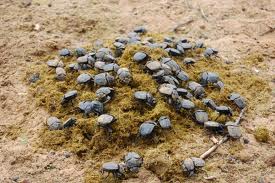
SOURCE:
Remembering Kwale
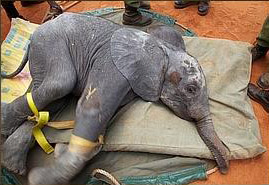 “It was all just too much for this little elephant rescued on the 6th September 2005 from community lands abutting the Shimba Hills National Reserve. Partly healed scars and wounds on his body were gruesome testimony to the aggression and harassment he must have endured since the loss of his elephant family by poachers. Kwale found himself orphaned and alone, desperately trying to escape a gruesome end for what must have been at least l0 days without the protection of his elephant family. A call came in to the David Sheldrick Wildlife Orphan Trust that a baby elephant had been found wondering alone, and within hours he was in the back of a pick-up truck for the 60 mile journey to the Voi Stockades, then into the rescue plane for the final journey to the Nairobi Nursery. After a check-up, which revealed a broken rib, and the mandatory anti-biotic injections from the vet, Kwale was getting weaker and it was more than he could take. He enjoyed a full day of milk, but on the second day, he succumbed to pneumonia exacerbated by chronic diarrhea.
“It was all just too much for this little elephant rescued on the 6th September 2005 from community lands abutting the Shimba Hills National Reserve. Partly healed scars and wounds on his body were gruesome testimony to the aggression and harassment he must have endured since the loss of his elephant family by poachers. Kwale found himself orphaned and alone, desperately trying to escape a gruesome end for what must have been at least l0 days without the protection of his elephant family. A call came in to the David Sheldrick Wildlife Orphan Trust that a baby elephant had been found wondering alone, and within hours he was in the back of a pick-up truck for the 60 mile journey to the Voi Stockades, then into the rescue plane for the final journey to the Nairobi Nursery. After a check-up, which revealed a broken rib, and the mandatory anti-biotic injections from the vet, Kwale was getting weaker and it was more than he could take. He enjoyed a full day of milk, but on the second day, he succumbed to pneumonia exacerbated by chronic diarrhea.
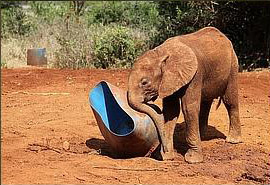 Vets and carers, in their initial attempts to save his life, failed to notice that Kwale had 5 toenails on his front feet and 4 on the hind. This meant that he was a very special elephant indeed, and one of the very few rare indigenous forest elephants from the coastal tropical forest that clothes the Shimba Hills. A different number of toenails on the front and the hind feet revealed that Kwale was a bush immigrant from an inland population which made the loss of him even more tragic. There were tears aplenty, but comfort in knowing that the last sound he would have heard as he lay dying, was the gentle comforting rumble from his new elephant friend, Rapsu. Knowing he was not alone would surely have made his passing a more peaceful and loving end.
Vets and carers, in their initial attempts to save his life, failed to notice that Kwale had 5 toenails on his front feet and 4 on the hind. This meant that he was a very special elephant indeed, and one of the very few rare indigenous forest elephants from the coastal tropical forest that clothes the Shimba Hills. A different number of toenails on the front and the hind feet revealed that Kwale was a bush immigrant from an inland population which made the loss of him even more tragic. There were tears aplenty, but comfort in knowing that the last sound he would have heard as he lay dying, was the gentle comforting rumble from his new elephant friend, Rapsu. Knowing he was not alone would surely have made his passing a more peaceful and loving end.
Rest in Peace Kwale, a precious little elephant in the first year of his life, who succumbed to the hardships endured by the conflict that exists between people and elephants.”
SOURCE:







